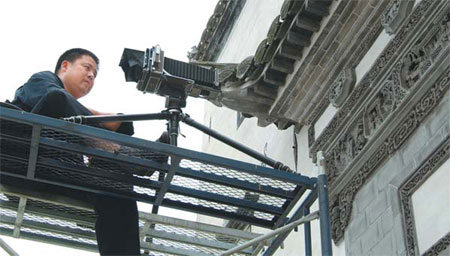 |
|
Zhang Jianping, a photographer who has been taking pictures of Hui-style architecture for more than two decades. Provided to China Daily
|
Rapid reconstruction and modernization in rural China in the last few decades had posed a major threat to the preservation of Hui-style architecture.
While some houses were torn down and replaced by new concrete buildings, some were dismantled into stone and wooden sculptures and ornaments that were traded by antique dealers at prices as high as hundreds of thousands of yuan.
That's when Zhang's hobby turned into a mission.
"The more I see, the more tortured I am: To see the beautiful destroyed before my eyes again and again," Zhang says, his voice cracking.
The moment he presses the shutter is usually the last time he sees that architecture, which will soon make way for another modern building.
"These old houses were built with their natural surrounding and neighborhood in mind. The modern buildings, on the other hand, are rampant in their competition to be taller and bigger on the expenses of public spaces. It also shows the difference between two eras," Zhang says.
The situation of Hui-style architecture roused widespread attention in April when kung fu star Jackie Chan told the public about his decision to donate his collection of 10 historic Hui-style houses to a Singaporean university.
Zhang says these architectures, after being uprooted from their original location, will lose a great deal of its significance.
"Each house has its own life. There is a dialogue between the architecture and its natural surrounding. Without that dialogue, the house is not exactly what it is," he says.
But, the importance Singapore has attached to the restoration is worth learning from, Zhang says, citing another example of Yinyutang, a Hui-style house that was relocated to the Peabody Essex Museum in the United States in the 1990s.
"Take Yinyutang for example, even the old newspapers from the "cultural revolution" (1966-76) period on the door were treated carefully when the house was dismantled," he says.
For Zhang, despite all the agony and struggles, he has always been clear about his mission: To preserve the memory of the old Huizhou as much as he can. He is now preparing for a new photo album Vanishing Huizhou, expected to be out in September.
We recommend:
